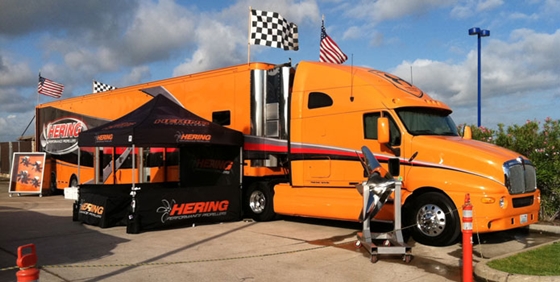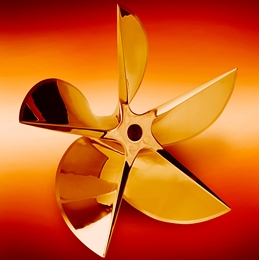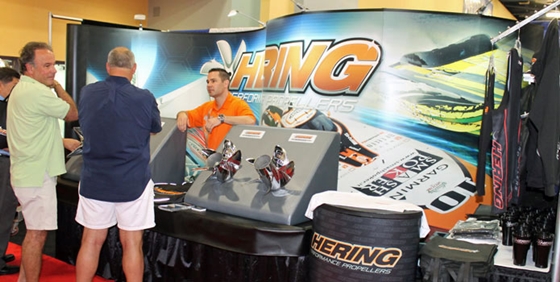Hering Propellers: Back in the Family
The vaunted high-performance prop company is once more in the hands of the man who made it great.
June 14, 2012
The recent news that Hering Propellers in Marysville, Wash., had been sold back to Jim Hering caught just about everyone who wasn’t actually in on the deal by surprise. Hering sold the high-performance powerboat propeller company to private investor Eric Hammon in 2007, and Hammon worked to increase the company’s number of CNC (computer numerical control) milling machines and boost its foundry output.
But the years since the sale of Hering have not been kind to the marine industry and even less so to the go-fast boat segment. For Hammon, who funneled serious resources into the company, four-plus years was enough. And to his credit, he left things better than he found them in many ways. That isn’t something everyone who buys and later sells a company can say.
Jim Hering certainly knew what he was buying back. Hering’s father, Bob, a former powerboat racer, founded Hering Propellers in the 1980s. Although the company built a strong reputation for product quality in its early years, it really didn’t take off in a big way until Jim took the reins. A talented propeller designer in his own right, Jim Hering built the company into a significant threat—in offshore race boats and the top shelf of high-performance pleasure boats—to Mercury Marine Propeller Company, the largest manufacturer of propellers in the world.
Now, Hering is back—and happy to be there.

The Hering support trailer was among the many improvements the company added under its former owner.
“I have reacquired the assets of the company,” said Hering. “I’ve actually been involved with running the company since November [2011]."
The ownership change will not disrupt delivery of existing or future propeller orders, according to Jeff Johnston, the company’s vice president of sales and marketing.
“Our customers don’t have to worry about that,” said Johnston. “Jim has been working with the company, and everything we’re producing is on track.
“The transition is seamless,” added Hering. “And Jeff is still going to be doing what he does. He is the face of the company.”
According to Hering, the company, which had an outstanding reputation for product quality as well as product delivery during his tenure, made significant strides under the previous owner.
“We’ve increased our number of CNC mills—we now have 11—by 50 percent,” said Hering. “We also have expanded our foundry capacity.
“We have the support truck now, and that’s had a good, positive impact on the marketing side of our business,” he added. “They put a lot more emphasis on marketing than I used to.”
At present, Hering offers cast and forged propellers in pitch sizes from 19 to 41 inches for big-power offshore wave crushes to outboard engine-powered aquatic hot rods. Prices are not for the faint of heart. A set of five-blade cast Hering wheels costs $10,500, whereas a set of stronger forged five-blade propellers rings in at $23,000.
Why the dramatic price difference? In the casting process, Hering pours stainless steel into a casting and then CNC mills it to its finished state. In the forging process, Hering builds each props in sections from tip to hub, then assembles the sections through welding, heat treating, and CNC milling. The rest of the process, as well as the specific stainless-steel material used, is proprietary.
“From start to finish, the time involved for a forged propeller is a least three times the amount of time required to make a cast propeller,” said Johnston.

Hering makes cast and forged “offshore” propellers (shown here) as well as propellers for outboard engine performance boats.
About two years ago, the company unveiled a line of cast titanium propellers. The lighter propeller were targeted at “mid-powered” boats with twin 500- to 750-hp engines, and showed strong results right out of the box. However, thanks to the economy and an inherent cost issue, Hering’s titanium line has not taken off as hoped.
“Their performance is great, and their strength characteristics are the same as our cast stainless-steel propellers,” said Johnston. “But we don’t have the ability to pour them in our foundry, so we have to subcontract that part, and that raises the prices to $15,000 a set. So that’s made things more difficult.”
While Hering built much of its early reputation in the offshore powerboat-racing world, offshore racers do not represent the majority of the company’s customers. Roughly 30 percent of Hering’s sales go to offshore racers. The rest end up on high-performance pleasure boats, and most of those go to private customers as opposed to boatbuilders.
Johnston also took pains to point out that while Hering does consider Mercury Marine Propellers a competitor, the company does not view Mercury Racing, the world leader in high-performance powerboat engines, the same way. “I work with Randy Scism at MTI, Peter Hledin at Skater, and a lot of others on propping boats behind Mercury Racing engines from the 700 to the 1350 and drives. More often than not, we’re propping behind complete Mercury Racing drives trains. So we don’t see Mercury Racing as a threat.”
Moving forward, Hering will bring his considerable talents back to propeller design and development. “That’s pretty much what I’m already doing, handling the technical and operational sides of things,” he said.
Added Johnston, “Our focus hasn’t changed. We are dedicated to continually improve the performance of our propellers.”
- Matt Trulio













